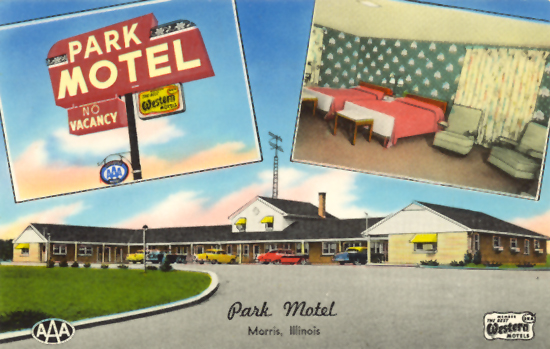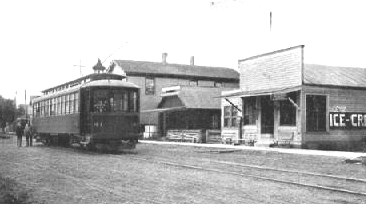
|
|
|
|
|
|
By
the late 1920s, the predecessor road to Route 6 (Illinois 7) had bypassed
downtown Morris. This created a highway-oriented commercial strip
north of town, which in recent decades has been reinforced and
expanded because of its proximity to an I-80 interchange. The Park
Motel is located at near the center of that strip. |
|
|
|
|
Morris is in the middle of a significant transportation corridor. Two major nineteenth century components of the corridor were the 1848 Illinois and Michigan Canal, which linked the river to the lake, and the 1854 Chicago and Rock Island Railroad, which connected the eastern rail network to the Mississippi River, and eventually beyond. By the 1890s, in Illinois and most parts of the United States, a rather full rail network connected most settlements of large or medium size, and electric trolley networks within towns and cities provided for local public transportation. Then in the years around the turn of the century, electricity-powered "interurban" trolleys were added to the mix. They served a intermediate role between the steam trains and the local trolleys, connecting small towns with more frequent service than the steam railroads could provide. Interurban networks radiated outward from many American cities, including Chicago and Los Angeles. The above 1914 map shows one of numerous lines that served the Chicago region, the Chicago, Ottawa, and Peoria. Its main line paralleled the Rock Island Railroad and the Illinois River, serving all of today's Route 6 towns from Joliet to Spring Valley. Two of its branches connected these towns with other railroads: the Burlington Route at Princeton and the Santa Fe at Streator. The interurban era in the Unted States was short-lived. By the 1920s, when automobile ownership and paved highways were proliferating rapidly, interurban lines began to close. Most did not last through the depression of the 1930s. The automobile and the numbered highways took over the role played by the interurbans in connecting small towns to one another. (map courtesy of The University of Texas Libraries, University of Texas at Austin) (to access the entire map, visit: http://www.lib.utexas.edu/maps/mcgraw_electric.html )
|
 |
This early twentieth century postcard shows an interurban rail car going through Seneca, which is located twelve miles west of Morris. The Chicago, Ottawa, and Peoria line was part of the Illinois Traction Company whose interurban network covered parts of central Illinois and went as far south as East St. Louis. The line from Joliet to Princeton was constructed in segments between 1902 and 1912, the part between Morris and Seneca in 1909. Parts of the line were closed in 1929, and all of it in 1934. Route 6 took over. |